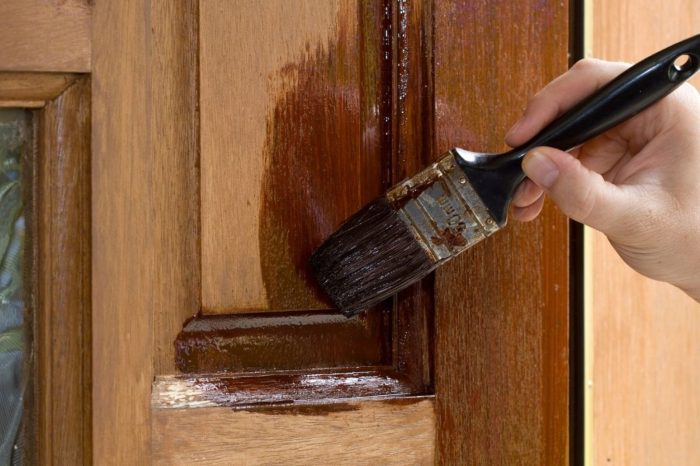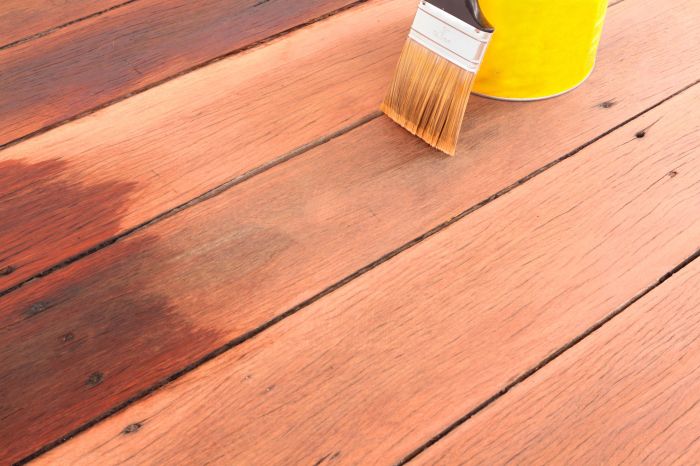Exploring the World of Exterior Wood Stain: A Comprehensive Guide
As exterior wood stain takes center stage, this opening passage beckons readers into a world crafted with good knowledge, ensuring a reading experience that is both absorbing and distinctly original.
When it comes to exterior wood stain, there's more than meets the eye. From enhancing durability to adding a touch of style, this guide dives deep into the realm of exterior wood stain, offering insights and tips for a successful staining project.
Introduction to Exterior Wood Stain

Exterior wood stain is a type of coating that is applied to wooden surfaces to protect them from the elements and enhance their appearance. It penetrates the wood to provide a durable layer of protection against moisture, UV rays, and other environmental factors.
Using exterior wood stain offers several benefits, such as prolonging the life of the wood by preventing rot and decay, reducing maintenance costs by requiring less frequent reapplications compared to paint, and enhancing the natural beauty of the wood grain.
Types of Exterior Wood Stain
- Semi-Transparent Stain: This type of stain allows the natural wood grain to show through while adding color and protection. It is ideal for enhancing the appearance of wood without completely hiding its texture.
- Transparent Stain: Transparent stains provide minimal color but offer protection against moisture and UV damage. They are suitable for preserving the natural look of the wood.
- Solid Stain: Solid stains provide a painted-like finish with a wide range of color options. They offer maximum protection and coverage, making them ideal for heavily weathered or damaged wood surfaces.
Factors to Consider Before Staining

Before embarking on staining your exterior wood surfaces, there are several important factors to consider to ensure a successful outcome.
Types of Wood Suitable for Exterior Wood Staining
Not all types of wood are suitable for exterior wood staining. Hardwoods like oak, mahogany, and teak are popular choices due to their durability and ability to absorb stain evenly. Softwoods like pine and cedar are also commonly used but may require additional preparation to achieve optimal results.
Importance of Preparing the Wood Surface
Properly preparing the wood surface is crucial for the stain to adhere correctly and ensure a long-lasting finish. This includes sanding the wood to remove any existing finish, cleaning the surface to remove dirt and debris, and applying a wood conditioner if necessary to promote even stain absorption.
Impact of Weather Conditions on Staining
Weather conditions can significantly impact the staining process and the final result. Extreme heat can cause the stain to dry too quickly, leading to uneven application and potential cracking. High humidity can prevent the stain from properly drying, resulting in a sticky or tacky finish.
To mitigate these effects, it is recommended to stain your exterior wood surfaces on a mild, dry day with moderate temperatures.
Application Methods
When it comes to applying exterior wood stain, there are several techniques that can be used to achieve the desired results. It is important to choose the right method based on the type of wood, the size of the project, and personal preference
Brushing
Brushing is a traditional method of applying wood stain that allows for precision and control. It is ideal for smaller projects or areas that require detailed work. To achieve an even application when brushing, make sure to follow the wood grain and apply thin, even coats.
Spraying
Spraying is a faster method of applying wood stain, making it suitable for larger projects or areas that need to be covered quickly. When spraying, it is important to use the right equipment to ensure an even coat. Be sure to protect surrounding surfaces from overspray.
Wiping
Wiping involves applying the stain with a cloth or rag, allowing for more control over the depth of color and coverage. This method is great for achieving a more natural or rustic look. To ensure an even application, wipe in the direction of the wood grain and avoid leaving excess stain on the surface.
It is important to always follow the manufacturer's instructions for application methods to ensure the best results and longevity of the finish.
Maintenance and Care
Proper maintenance and care are essential for preserving the beauty and longevity of exterior wood stain. Regular upkeep ensures that your stained wood surfaces remain in top condition for years to come.
Cleaning Stained Wood Surfaces
To clean stained wood surfaces properly, start by removing any debris or dirt with a soft-bristled brush or a gentle cleaning solution. Avoid using harsh chemicals or abrasive tools that can damage the stain. Once the surface is clear, you can wash it with a mixture of mild soap and water, then rinse thoroughly with clean water.
Allow the wood to dry completely before applying any additional treatments or finishes.
Reapplying Stain for Long-Lasting Results
It is important to monitor the condition of your stained wood surfaces regularly to determine when it's time to reapply the stain. Factors like exposure to sunlight, moisture, and wear and tear can affect the longevity of the stain. Look for signs of fading, cracking, or peeling, as these indicate that the stain is no longer providing adequate protection.
In general, it's recommended to reapply exterior wood stain every 2-3 years to maintain its durability and appearance.
End of Discussion
In conclusion, exploring the nuances of exterior wood stain opens up a realm of possibilities for protecting and beautifying your outdoor wooden surfaces. By understanding the purpose, application methods, and maintenance tips discussed, you are well-equipped to embark on your staining journey with confidence and expertise.
Common Queries
Which types of wood are suitable for exterior wood staining?
Hardwoods like oak and redwood are ideal for exterior wood staining due to their natural durability and resistance to rot.
How often should I reapply exterior wood stain?
It's recommended to reapply exterior wood stain every 2-3 years for optimal protection and longevity of the wood surface.
What are the best practices for maintaining exterior wood stain?
Regularly inspecting the stained wood surface for any signs of wear, cleaning it gently with a mild detergent, and avoiding harsh chemicals are key maintenance practices.